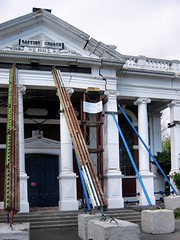
Search
Images for canterbury earthquakes; more images...
Photo 027
Images, UC QuakeStudies
A crack in the Avon river bank in Avonside after the September 4th earthquake.
Power Cable Section
Images, Canterbury Museum
One section of power cable with cut ends, covered in rubber and black electrical tape; two smaller cables branching off the main section; damaged and twisted in the 22 February 2011 earthquake. One of the most noticeable effects of the earthquakes in Canterbury was the loss of basic infrastructure such as power, water and sewerage. The earthqu...
2010 - Photograph of the Student Volunteer Army
Images, UC QuakeStudies
A photograph of University of Canterbury students carrying wheelbarrows, shovels and spades to help clean up liquefaction in earthquake-damaged areas after the September 2010 earthquake.
Christchurch Earthquake 22/02/11
Images, eqnz.chch.2010
Structural engineers taking a break on the roof of the Warners Hotel, Cathedral Square.
Christchurch Earthquake 22/02/11
Images, eqnz.chch.2010
Corin Dann reporting from the Christchurch Art Gallery/Civil Defence Headquarters for TVNZ.
Christchurch Earthquake 22/02/11
Images, eqnz.chch.2010
Palmers Road, near the corner of Caithness Street, New Brighton, Christchurch.
Christchurch fiasco
Other, National Library of New Zealand
Blog in which Sarah Miles comments on the post-earthquake reconstruction of Christchurch, critiquing the profit-driven model of private insurance and how it fails to protect citizens in times of disaster. Includes comment on the political situation and some guest posts.
S.K.I.P : strategies with kids, information for parents.
Other, National Library of New Zealand
SKIP is a government funded initiative that supports parents and whanau to guide their children's behaviour in a positive way. Earthquake related information can be found in the archived instances from September 2010-
Landcheck.org.nz
Other, National Library of New Zealand
CERA site which allows a check of the status of residental property in greater Christchurch in the aftermath of the series of major earthquakes and aftershocks which began in September 2010. Also has information about the zone classifications and FAQs.
Ministry of Civil Defence & Emergency Management = Te Rakau Whakamarumaru.
Other, National Library of New Zealand
Information about CDEM planning, programmes and the Ministry itself. Includes emergency preparedness information for the public and downloadable resources for civil defence sector workers. Earthquake related information can be found in the archived instances from September 2010-
London Street Canterbury Street corner - Ground Cafe
Images, eqnz.chch.2010
Photos taken in Lyttelton following the February 22 earthquake. File ref: CCL-2011-03-05-After-The-Earthquake-P1110507 From the collection of Christchurch City Libraries
Object Overview: Earthquake Hazard Assessment for Waimate, Mackenzie and p…
Articles, UC QuakeStudies
Object Overview of 'Earthquake Hazard Assessment for Waimate, Mackenzie and part Waitaki districts (Yetton & McCahon, 2008).'
Jacqui Gavin's Story
Articles, UC QuakeStudies
Summary of oral history interview with Jacqui Gavin about her experiences of the Canterbury earthquakes.
Nicky Wagner's Story
Articles, UC QuakeStudies
Summary of oral history interview with Nicky Wagner about her experiences of the Canterbury earthquakes.
Photograph number UC 11-0055-05
Images, UC QuakeStudies
UBS has reopened following the February earthquake.
Photograph number UC 10-0498-094
Images, UC QuakeStudies
Facilities Management staff meet after the earthquake.
Photograph number UC 10-0498-100
Images, UC QuakeStudies
Facilities Management staff meet after the earthquake.
Photograph number UC 10-0498-098
Images, UC QuakeStudies
Facilities Management staff meet after the earthquake.
Photograph number UC 10-0498-095
Images, UC QuakeStudies
Facilities Management staff meet after the earthquake.
Photograph number UC 10-0526-36
Images, UC QuakeStudies
Building damaged by fire after the earthquake.
Photograph number UC 10-0498-096
Images, UC QuakeStudies
Facilities Management staff meet after the earthquake.
Photograph number UC 10-0498-099
Images, UC QuakeStudies
Facilities Management staff meet after the earthquake.
Photograph number UC 10-0498-097
Images, UC QuakeStudies
Facilities Management staff meet after the earthquake.
Photograph number UC 10-0526-35
Images, UC QuakeStudies
Building damaged by fire after the earthquake.
Geotechnical Aspects of the 2010 Darfield (Canterbury) Earthquake
Research papers, University of Canterbury Library
On 4 September 2010, a magnitude Mw 7.1 earthquake struck the Canterbury region on the South Island of New Zealand. The epicentre of the earthquake was located in the Darfield area about 40 km west of the city of Christchurch. Extensive damage was inflicted to lifelines and residential houses due to widespread liquefaction and lateral spreading in areas close to major streams, rivers and wetlands throughout Christchurch and Kaiapoi. Unreinforced masonry buildings also suffered extensive damage throughout the region. Despite the severe damage to infrastructure and residential houses, fortunately, no deaths occurred and only two injuries were reported in this earthquake. From an engineering viewpoint, one may argue that the most significant aspects of the 2010 Darfield Earthquake were geotechnical in nature, with liquefaction and lateral spreading being the principal culprits for the inflicted damage. Following the earthquake, an intensive geotechnical reconnaissance was conducted to capture evidence and perishable data from this event. This paper summarizes the observations and preliminary findings from this early reconnaissance work.
Digital Archive of Christchurch's Earthquakes
Audio, Radio New Zealand
The University of Canterbury's CEISMIC project is building a digital archive of earthquake-related information
Nisbet, Alastair, 1958- :'Sob!'. 6 September 2012
Images, Alexander Turnbull Library
On the second anniversary of the 2010 earthquake Canterbury weeps. Quantity: 1 digital cartoon(s).
Canterbury Television's Emily Cooper
Audio, Radio New Zealand
CTV journalist Emily Cooper was out filming when the Canterbury earthquake hit. Fifteen of her colleagues are unaccounted for.
SPCA Canterbury Photograph 06
Images, UC QuakeStudies
A photograph of an SPCA animal attendant and veterinarian attending to a puppy after the 22 February 2011 earthquake.
Book and DVD: Earthquake, Christchurch New Zealand 22 February 2011
Images, Canterbury Museum
One book titled "Earthquake, Christchurch New Zealand 22 February 2011" with text by Chris Moore and Press journalists and images by Press and Fairfax photographers; colour illustrations; published by A Random House New Zealand, Auckland, 2011; accompanying DVD. The sombre tone of this book and DVD reflects the attitudes of the greater Christch...



